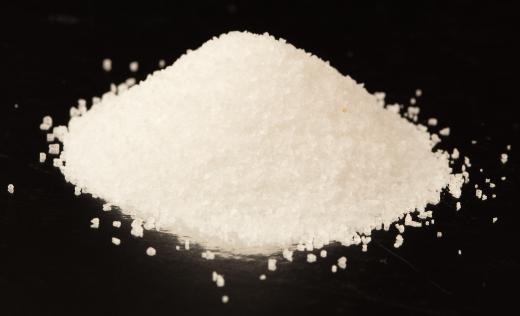What Is the Connection between Sodium Carbonate and Sulfuric Acid?
Sodium carbonate and sulfuric acid — important chemicals individually and in combination — are on opposite sides of the pH scale; sodium carbonate (Na2CO3) is a fairly basic salt, whereas sulfuric acid (H2SO4) is one of the strongest mineral acids. Close consideration of its chemical structure reveals that sodium carbonate can be produced from sodium hydroxide (NaOH), plus carbonic acid (H2CO3); the salt of such a weak acid with such a strong base is not neutral, but basic. The equation for this is 2 NaOH + H2CO3 → Na2CO3 + 2 H2O. Alternatively, if left exposed to the air, sodium hydroxide very slowly absorbs carbon dioxide (CO2) from the atmosphere, obeying the relationship 2 NaOH + CO2 → Na2CO3 + H2O. Either way, the reaction between sodium carbonate and sulfuric acid is Na2CO3 + H2SO4 → Na2SO4 + H2O + CO2, where Na2SO4 is the chemical formula for sodium sulfate.
Carbonate of sodium bears the historic household name "washing soda," since because of its alkaline, or basic, properties, it improves the functioning of laundry detergents. Another name for it is soda ash, since an early primary source of it was from the ashes of trees, seaweed and other organic material. Its most important use today — representing nearly half its total production level — is in the manufacture of glass. Nearly 30% of its use, however, is for the production of chemicals. Sodium carbonate and sulfuric acid are used in the laboratory as standards against which other substances may be evaluated.

Sulfuric acid is among the most important industrial chemicals throughout the world, particularly in Asia and the United States, and is especially critical to the production of phosphate fertilizers. Rayon — originally a silk-substitute — employs sulfuric acid in its manufacture. Sodium sulfate, a major byproduct in rayon manufacture, does not generally result from the combining of sodium carbonate and sulfuric acid. Rather, it results when sodium hydroxide (NaOH) — the so-called caustic soda — is used to neutralize "spent" acid. The acid is also used in automotive batteries, in steel manufacture, and in the production of explosives.

Molecules of water associate with the simple Na2SO4 molecule to form hydration products, including the building-damaging heptahydrate (Na2SO4·7H2O). Damage occurs because soluble salts can travel into pores and exert stressful pressure; thankfully, another hydrate — Glauber’s salt (Na2SO4·10H2O), the decahydrate — is being evaluated for a positive use in latent heat storage in heating and cooling systems. The pulp industry utilizes sodium sulfate in the Kraft process for paper-making. Medicinally, the salt is used as a cathartic, a diuretic and a purgative.
AS FEATURED ON:
AS FEATURED ON:












Discuss this Article
Post your comments